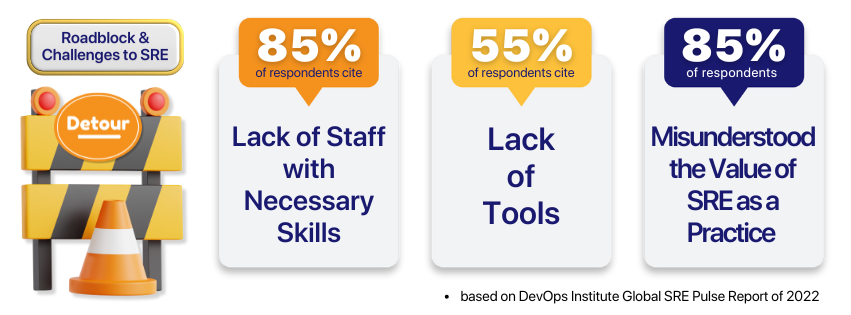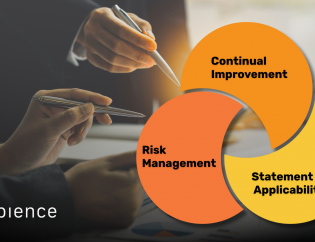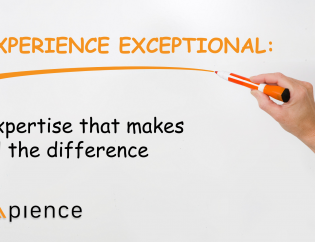The Future of SRE ? The Future is SRE !
Written by:
Principal Consultant
Sapience Consulting

Organisations across the globe are embracing digital transformation to stay competitive and innovative in a world that is evolving rapidly. One of the undisputed enablers for sustaining the transformation is the adoption of Site Reliability Engineering (SRE) practices. Pioneered by Google, but adopted successfully by like-minded organisations, SRE is rapidly gaining traction among businesses striving for reliability, efficiency, and scalability in their IT operations. Let us explore why SRE practices are becoming indispensable in the digital transformation journey.
What is Site Reliability Engineering?
Succinctly, Site Reliability Engineering (SRE) is a set of principles and practices that incorporates software engineering and applies it to infrastructure and operations problems. The end goal is to create scalable and highly reliable software systems in support of the elasticity and growth expected from the business services it supports. SRE uses a combination of automation, monitoring, and proactive identification of issues to ensure systems run smoothly.

Google introduced SRE in the early 2000s when it faced significant challenges in maintaining the reliability of its rapidly growing services. The company realised that traditional IT operations couldn’t keep up with the scale and complexity of its infrastructure. Through a fundamental paradigm shift of treating infrastructure and operations as a software problem, Google was able to innovate and automate much of its operational workload, leading to more reliable and efficient systems.


Why SRE is Gaining Traction ?

1. Reliability and Uptime is Paramount
In today’s digital age, downtime can lead to significant financial losses and damage to a company’s reputation. For instance, a 2019 study by Gartner revealed that the average cost of IT downtime is about US 5,600 per minute. SRE practices help organisations maintain high reliability and uptime by proactively identifying and addressing potential issues before they escalate into outages. The emphasis on monitoring, alerting, and incident response ensures that systems remain operational and any disruptions are minimised.
2. Efficient Scalability Matters
As businesses grow, their IT infrastructure needs to scale efficiently. SRE practices, with their focus on automation and engineering solutions, enable organisations to manage large-scale systems without a proportional increase in operational workload. This scalability is crucial for companies experiencing rapid growth or seasonal spikes in demand. For example, e-commerce giants like Amazon rely heavily on SRE principles to handle massive traffic during events like Black Friday without compromising on performance.


3. Cost Efficiency (aka Cheaper!)
Automation is the bedrock of SRE. By automating routine tasks, organisations can reduce the need for manual intervention, leading to significant cost savings. A report by McKinsey & Company highlighted that businesses could reduce their operational costs by 20-30% through effective automation. Additionally, by preventing outages and reducing downtime, companies can avoid the hefty financial penalties associated with system failures.

4. Improved Collaboration and Culture
SRE will more often than not require a rethink of organisational design, which if done correctly will foster a culture of collaboration (breaking down silos) between development and operations teams, creating a more cohesive and agile IT environment. The adoption of a shared responsibility model, where both developers and operations share accountability for the system’s reliability, ensures that everyone works towards common goals.


5. Competitive Advantage with Meaningful Innovation
In a fast-paced digital landscape, the ability to innovate quickly in areas most meaningful for the business is a significant competitive advantage. SRE practices enable organisations to deploy new features and updates rapidly without compromising on reliability. This agility allows businesses to respond swiftly to market changes and customer needs. Companies like Netflix have leveraged SRE principles to continuously deliver new content and features, maintaining their position as leaders in the entertainment industry.
Some Key Aspects of SRE
Some Key Aspects of SRE 👨🍳 🍕 🥘 🧀 🍅 🧅 🧄 🌶️ 🫑 🫓
Understanding the contribution of the different aspects of SRE is akin to asking what makes a great pizza. Is it the type and quality of cheese? Is it the dough? Is it the tomato-based sauce? Or perhaps the salami pieces? Or is it the expert combination of the various ingredients – in perfect balance – at the hand of the pizza maker? SRE as a practice is expected to collectively deliver more pow-wow than the sum of its parts – with expert guidance by leadership and practitioners.
Having said that, let’s look at the cheeses and salamis……

1. Service Level Objectives (SLOs) and Error Budgets
This underpins SRE. SLOs are specific, measurable goals for system performance and availability that provide a clear benchmark for reliability from the user perspective. Error budgets represent the permissible amount of downtime or errors within a given period. By defining and monitoring SLOs and error budgets, organisations can make informed decisions about balancing new feature releases and system reliability.

2. Automation
Automation is critical (being necessary but not sufficient) to SRE. By automating repetitive tasks – dismissively called “toil” - such as deployment, scaling, and incident response, organizations can reduce human error, increase efficiency, and focus on more strategic activities. Tools like Kubernetes and Terraform are commonly used in SRE for infrastructure automation.

3. Monitoring and Observability
Effective monitoring and observability are essential for proactive incident management. SRE teams use a variety of tools to collect and analyse data from system logs, metrics, events, and traces. This visibility helps in identifying issues early and understanding their underlying causes. Prometheus and Grafana are popular tools for monitoring and visualisation in SRE.

4. Incident Management
Sustainable incident management involves structured processes for responding to and resolving system issues. SRE teams use runbooks, playbooks, and post-incident reviews to ensure swift and effective incident resolution, and more importantly gain wisdom from issues that affect the business.
Expect Road Bumps
While SRE offers numerous benefits, its implementation is seldom frictionless.
Organisations need to invest in the right tools, training, and cultural changes to successfully adopt SRE practices. Resistance to change, lack of expertise, and initial costs can be significant hurdles that derail implementation. However, the long-term gains in reliability, efficiency, and innovation make it a worthwhile investment – for organisations that persevere.

As more organisations embark on their digital transformation journeys, the adoption of SRE is expected to grow. The increasing complexity of IT environments, coupled with the need for rapid innovation and high reliability, will drive the demand for SRE practices.
Site Reliability Engineering is not just the flavour of the month. It is not surprising that in a separate DevOps Institute report, 88% of organisations surveyed plan to increase their adoption of SRE practices over the next two years. With its roots in Google’s brilliant pioneering efforts, it is reshaping the landscape of IT operations with organisations like Spotify and AirBnB adopting these practices.
The adoption of SRE will be crucial in ensuring sustainable growth, innovation, and success. Ultimately, it is not about IT Operations. It is about the business. It is inevitable. It is the FUTURE and it is here.
Check out our IBF-approved courses! There is no better time to upskill than now!
















